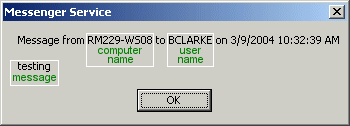| You
may have heard of net send. It's used mostly by network administrators
to tell network users important information. An example would
be if the server was going down for maintenance, the administrator
would send out a message to the entire Workgroup. A Workgroup
is a subdivision of a network that groups computers or employees
performing similar or related tasks (like a certain department).
The
following is the syntax of the net send command:
net send {name | * | /domain[:name] | /users}
message
| Format |
Meaning |
| Italic |
Information
that the user must supply |
| Bold |
Elements
that the user must type exactly as shown |
| Between
brackets ([]) |
Optional
items |
| Between
braces ({}; choices separated by pipe (|). Example:
{even|odd} |
Set
of choices from which the user must choose only one |
The
syntax above may be a little confusing. It basically boils
down to this:
net send name message
Replace
name with a username (ex: bclarke), a computer
name (ex: RM229-WS08), a domain (ex: mshome), or an asterisk
(*). Replacing name
with * will send the message to every user on the network.
Replacing name with
a domain will send your message to all the computers on that
domain.
Replace
message with your message (duh).
After
you done typing net send name message hit enter and you will be told if you message has been successfully delived.
The
following is what the recipient of you message will see. The
white boxes and green text was added to explain what some
of the things are.

Be
advised that administrators have the ability to see who sent
messages and to whom they were sent to. They could also see
the message.
|


